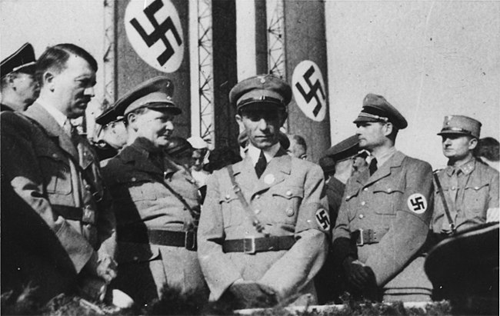Garden city movementby Wikipedia
Accessed: 11/21/19
Fritsch's 1896 book The City of the Future became a blueprint of the German garden city movement which was adopted by Völkisch circles.-- Theodor Fritsch, by Wikipedia
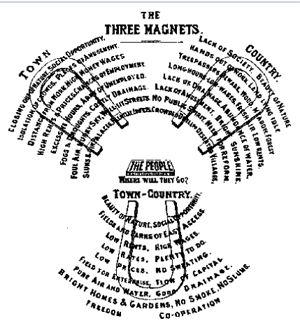 Ebenezer Howard's 3 magnets diagram which addressed the question 'Where will the people go?', with the choices 'Town', 'Country' or 'Town-Country'
Ebenezer Howard's 3 magnets diagram which addressed the question 'Where will the people go?', with the choices 'Town', 'Country' or 'Town-Country'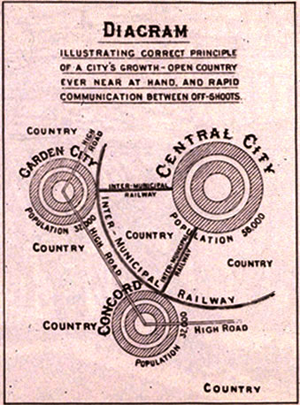
The garden city movement is a method of urban planning in which self-contained communities are surrounded by "greenbelts", containing proportionate areas of residences, industry, and agriculture. The idea was initiated in 1898 by Ebenezer Howard in the United Kingdom and aims to capture the primary benefits of a countryside environment and a city environment while avoiding the disadvantages presented by both. Howard was knighted in 1927. During his lifetime Letchworth and Welwyn Garden City were built near London according Howard’s concept and many other garden cities inspired by his model have since been build all over the world.[1]
History
Conception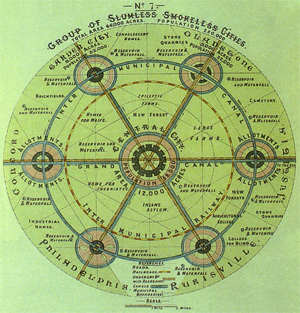
Inspired by the utopian novel Looking Backward and Henry George's work Progress and Poverty, Howard published the book To-morrow: a Peaceful Path to Real Reform in 1898 (which was reissued in 1902 as Garden Cities of To-morrow). His idealised garden city would house 32,000 people on a site of 6,000 acres (2,400 ha), planned on a concentric pattern with open spaces, public parks and six radial boulevards, 120 ft (37 m) wide, extending from the centre. The garden city would be self-sufficient and when it reached full population, another garden city would be developed nearby. Howard envisaged a cluster of several garden cities as satellites of a central city of 58,000 people, linked by road and rail.[2]
Howard's To-morrow: A Peaceful Path to Real Reform sold enough copies to result in a second edition, Garden Cities of To-morrow. This success provided him the support necessary to pursue the chance to bring his vision into reality. Howard believed that all people agreed the overcrowding and deterioration of cities was one of the troubling issues of their time. He quotes a number of respected thinkers and their disdain of cities. Howard's garden city concept combined the town and country in order to provide the working class an alternative to working on farms or in ‘crowded, unhealthy cities’.[3]
First developmentsTo build a garden city, Howard needed money to buy land. He decided to get funding from "gentlemen of responsible position and undoubted probity and honour".[4] He founded the Garden City Association (later known as the Town and Country Planning Association or TCPA), which created First Garden City, Ltd. in 1899 to create the garden city of Letchworth.[5] However, these donors would collect interest on their investment if the garden city generated profits through rents or, as Fishman calls the process, ‘philanthropic land speculation’.[6] Howard tried to include working class cooperative organisations, which included over two million members, but could not win their financial support.[7] Because he had to rely only on the wealthy investors of First Garden City, Howard had to make concessions to his plan, such as eliminating the cooperative ownership scheme with no landlords, short-term rent increases, and hiring architects who did not agree with his rigid design plans.[8]
In 1904, Raymond Unwin, a noted architect and town planner, and his partner Barry Parker, won the competition run by First Garden City Ltd. to plan Letchworth, an area 34 miles outside London.[9] Unwin and Parker planned the town in the centre of the Letchworth estate with Howard's large agricultural greenbelt surrounding the town, and they shared Howard's notion that the working class deserved better and more affordable housing. However, the architects ignored Howard's symmetric design, instead replacing it with a more ‘organic’ design.[10]
Letchworth slowly attracted more residents because it brought in manufacturers through low taxes, low rents and more space.[11] Despite Howard's best efforts, the home prices in this garden city could not remain affordable for blue-collar workers to live in. The populations comprised mostly skilled middle class workers. After a decade, the First Garden City became profitable and started paying dividends to its investors.[12] Although many viewed Letchworth as a success, it did not immediately inspire government investment into the next line of garden cities.
In reference to the lack of government support for garden cities, Frederic James Osborn, a colleague of Howard and his eventual successor at the Garden City Association, recalled him saying, "The only way to get anything done is to do it yourself."[13] Likely in frustration, Howard bought land at Welwyn to house the second garden city in 1919.[14] The purchase was at auction, with money Howard desperately and successfully borrowed from friends. The Welwyn Garden City Corporation was formed to oversee the construction. But Welwyn did not become self-sustaining because it was only 20 miles from London.[15]
Even until the end of the 1930s, Letchworth and Welwyn remained as the only existing garden cities in the United Kingdom. However, the movement did succeed in emphasizing the need for urban planning policies that eventually led to the New Town movement.[16]
Garden cities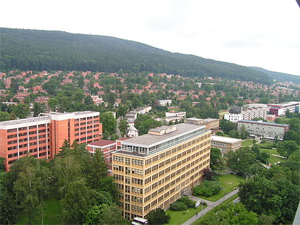 An attempt at a garden city: Zlín in Czech Republic (architect: František Lydie Gahura)
An attempt at a garden city: Zlín in Czech Republic (architect: František Lydie Gahura)Howard organised the Garden City Association in 1899. Two garden cities were built using Howard's ideas: Letchworth Garden City and Welwyn Garden City, both in the county of Hertfordshire, England, United Kingdom. Howard's successor as chairman of the Garden City Association was Sir Frederic Osborn, who extended the movement to regional planning.[17]
The concept was adopted again in the UK after World War II, when the New Towns Act spurred the development of many new communities based on Howard's egalitarian ideas.
The idea of the garden city was influential in other countries, including the United States. Examples include Residence Park in New Rochelle, New York; Woodbourne in Boston; Newport News, Virginia's Hilton Village; Pittsburgh's Chatham Village; Garden City, New York (parenthetically, the name "Garden City," as it applied to the Stewart-designed city on Long Island, incorporated in 1869, pre-dates that of the garden city movement, which was established some years later near the end of the nineteenth century); Sunnyside, Queens; Jackson Heights, Queens; Forest Hills Gardens, also in the borough of Queens, New York; Radburn, New Jersey; Greenbelt, Maryland; Buckingham in Arlington County, Virginia; the Lake Vista neighborhood in New Orleans; Norris, Tennessee; Baldwin Hills Village in Los Angeles; and the Cleveland suburbs of Parma[18] and Shaker Heights.
Greendale, Wisconsin is one of three "greenbelt" towns planned beginning in 1935 under the direction of Rexford Guy Tugwell, head of the United States Resettlement Administration, under authority of the Emergency Relief Appropriation Act. The two other greenbelt towns are Greenbelt, Maryland (near Washington, D.C.) and Greenhills, Ohio (near Cincinnati). The greenbelt towns not only provided work and affordable housing, but also served as a laboratory for experiments in innovative urban planning. Greendale's plan was designed between 1936 and 1937 by a staff headed by Joseph Crane, Elbert Peets, Harry Bentley, and Walter C. Thomas for a site that had formerly consisted of 3,400 acres (14 km2) of farmland.
In Canada, the Ontario towns of Don Mills (now incorporated into the City of Toronto) and Walkerville are, in part, garden cities, as well as the Montreal suburb of Mount Royal. The historic Townsite of Powell River, British Columbia[19] and the Hydrostone district of Halifax, Nova Scotia are recognized as National Historic Sites of Canada[20] built upon the Garden City Movement. In Montreal, la Cité-jardin du Tricentenaire is a classic form of Garden City located near the Olympic Stadium. All streets are cul-de-sacs and are linked via pedestrian paths to the community park.
 Svit in Slovakia - originally in 1934 planned as a combination of an industrial and garden city.
Svit in Slovakia - originally in 1934 planned as a combination of an industrial and garden city.In Peru, there is a long tradition in urban design[a] that has been reintroduced in its architecture more recently. In 1966, the 'Residencial San Felipe' in Lima's district of Jesus Maria was built using the Garden City concept.[21]
In São Paulo, Brazil, several neighbourhoods were planned as Garden Cities, such as Jardim América, Jardim Europa, Alto da Lapa, Alto de Pinheiros, Jardim da Saúde and Cidade Jardim (Garden City in Portuguese). Goiânia, capital of Goiás state, and Maringá are also examples of Garden Cities.
In Argentina, an example is Ciudad Jardín Lomas del Palomar, declared by the influential Argentinian professor of engineering, Carlos María della Paolera, founder of "Día Mundial del Urbanismo" (World Urbanism Day), as the first Garden City in South America.
In Australia, the suburb of Colonel Light Gardens in Adelaide, South Australia, was designed according to Garden City principles.[22] So too the town of Sunshine which is now a suburb of Melbourne in Victoria and the suburb of Lalor, also in Melbourne. The Peter Lalor Estate in Lalor takes its name from a leader of the Eureka Stockade and remains today in its original form. However it is under threat from developers and Whittlesea Council.[23][24] Lalor:Peter Lalor Home Building Cooperative 1946-2012 Scollay, Moira. Pre-dating these was the garden suburb of Haberfield in 1901 by Richard Stanton, organised on a vertical integrated model from land subdivision, mortgage financing, house and interior designs and site landscaping.[25]
Garden city ideals were employed in the original town planning of Christchurch, New Zealand. Prior to the earthquakes of 2010 and 2011, the city infrastructure and homes were well integrated into green spaces. The rebuild blueprint rethought the garden city concept and how it would best suit the city. Greenbelts and urban greenspaces have been redesigned to incorporate more living spaces.
Garden City principles greatly influenced the design of colonial and post-colonial capitals during the early part of the 20th century. This is the case for New Delhi (designed as the new capital of British India after World War I), of Canberra (capital of Australia established in 1913) and of Quezon City (established in 1939, capital of the Philippines from 1948–76). The garden city model was also applied to many colonial hill stations, such as Da Lat in Vietnam (est. 1907) and Ifrane in Morocco (est. 1929).
In Bhutan's capital city Thimphu the new plan, following the Principles of Intelligent Urbanism, is an organic response to the fragile ecology. Using sustainable concepts, it is a contemporary response to the garden city concept.
The Garden City movement also influenced the Scottish urbanist Sir Patrick Geddes in the planning of Tel Aviv, Israel, in the 1920s, during the British Mandate for Palestine. Geddes started his Tel Aviv plan in 1925 and submitted the final version in 1927, so all growth of this garden city during the 1930s was merely "based" on the Geddes Plan. Changes were inevitable.[26]
The Garden City movement was even able to take root in South Africa, with the development of the suburbs of Pinelands and Edgemead in Cape Town.
In Italy, the INA-Casa plan - a national public housing plan from the 1950s and '60s - designed several suburbs according to Garden City principles: examples are found in many cities and towns of the country, such as the Isolotto suburb in Florence, Falchera in Turin, Harar in Milan, Cesate Villaggio in Cesate (part of the Metropolitan City of Milan), etc.
In Belgium the Garden City movement took roots in the 1920s. After the First World War, there was a huge need for new housing. Social housing associations were created, often linked to political movements. In Brussels, Antwerp and Ghent new extensions of the city were build. These houses are still very popular among residents and classified as historical heritage. In the former Czechoslovakia, all industrial cities founded or reconstructed by the Bata Shoes company (Zlín, Svit, Partizánske) were at least influenced by the conception of the Garden City.
The Epcot Center in Bay Lake, Florida took some influence from Howard's Garden City concept while the park was still under construction.[27]Singapore, a tropical city has over time incorporated various facets of the Garden City concept in its town plans to try and make the country a unique City in a Garden.[28] In the 1970s, the country started including concepts in its town plans to ensure that building codes and land use plans made adequate provisions for greenery and nature to become part of community development, thereby providing a great living environment. In 1996, the National Parks Board was given the mandate to spearhead the development and maintenance of greenery and bring the island's green spaces and parks to the community.[29]
List of garden citiesThe localities in following lists have been developed directly as Garden Cities or their development has been heavily influenced by the Garden City movement.
United Kingdom and Ireland• Letchworth Garden City, England, United Kingdom
• Welwyn Garden City, England, United Kingdom
• Bedford Park, London, United Kingdom
• Hampstead Garden Suburb, London, United Kingdom
• Penkhull Garden Village, Stoke-on-Trent, United Kingdom
• St Helier, London, United Kingdom
• Milton Keynes, England, United Kingdom
• Telford, United Kingdom
• Bournville Village, Birmingham UK
• Moor Pool, Birmingham, United Kingdom
• The Garden Village, Kingston upon Hull, United Kingdom
• Glenrothes, Scotland, United Kingdom
• Marino, Dublin, Ireland
• Rosyth, Scotland, United Kingdom
• Tadpole Garden Village, Swindon UK
North America• The Public Works Administration of the New Deal created three Greenbelt communities based on the ideas of Ebenezer Howard which are now the municipalities of Greenbelt, Maryland, Greenhills, Ohio, and Greendale, Wisconsin.
• Mariemont, Ohio is one of the first cities in the US to be pre-planned as a garden community
• Park Circle (ca. 1912), North Charleston, South Carolina, United States
• Cité-jardin du Tricentenaire (Tricentennial Garden-City) (1940–1947), Montreal, Quebec, Canada
• Gardenvale neighbourhood, Sainte-Anne-de-Bellevue, Quebec, Canada (ca. 1918)
• Town of Mount-Royal, Montreal, Quebec, Canada
• Village Homes, Davis, California, United States
• Jackson Heights, Queens, New York City, United States
• Reston, Virginia, United States
• Sunnyside Gardens Historic District, Queens, New York, United States
• Epcot, Bay Lake, Florida
• Forest Hills, Boston
• Wyvernwood Garden Apartments, Los Angeles, California
• Fairview, Camden, New Jersey, United States
• Chatham Village, Pittsburgh, Pennsylvania, United States
• Kapuskasing, Ontario, Canada
• Radburn, New Jersey
France• Garden City, Suresne, Suresne, designed by Alexandre Maistrasse, Julien Quoniam and Félix Dumail
• Garden City, Stains, Stains, designed by Eugène Gonnot and Georges Albenque
• Garden City, Pré-Saint-Gervais, Pré-Saint-Gervais, designed by Félix Dumail
South America• Ciudad Jardín Lomas del Palomar, Buenos Aires, Argentina
• Viña del Mar, Chile
• Maringá, Brazil
Australia and New Zealand• Colonel Light Gardens, Adelaide, Australia
• Garden City, Victoria, in inner bayside Melbourne
• Peter Lalor Housing Estate, Lalor, Victoria, Australia
• The Sunshine Estate, Sunshine, Victoria, Australia
• Canberra, Australia
• Christchurch, New Zealand
• Wundowie, Western Australia
Europe• Covaresa, Valladolid, Spain
• Frohnau, Berlin, Germany
• Garbatella, Rome, Italy
• Gartenstadt [de], Mannheim, Germany
• Giszowiec, Katowice, Poland
• Hellerau, Dresden, Germany
• Konstancin-Jeziorna, Poland
• Mežaparks, Riga, Latvia
• Milanówek, Poland
• Svit, Slovakia
• Podkowa Leśna, Poland
• Tapiola, Finland
• Ullevål Hageby, Norway
• Velenje, Slovenia
• Wekerle estate, Budapest, Hungary
• Zelenograd, Moscow, Russia
• Zlín, Czech Republic
Asia• Den-en-chōfu, Ōta, Tokyo, Japan
• Kowloon Tong, Kowloon, Hong Kong, China
• Menteng, Jakarta, Indonesia
• Polonia, Medan, Indonesia
• Sha Tin, New Territories, Hong Kong, China
• Tel Aviv, Israel
Africa• Edgemead, Cape Town, South Africa[30]
• Pinelands, Cape Town, South Africa
CriticismsWhile garden cities were praised for being an alternative to overcrowded and industrial cities, along with greater sustainability, garden cities were often criticized for damaging the economy, being destructive of the beauty of nature, and being inconvenient. According to A. Trystan Edwards, garden cities lead to desecration of the country side by trying to recreate country side houses that could spread themselves; however, this was not a possible feat due to the limited space they had.[31]
More recently the environmental movement's embrace of urban density has offered an "implicit critique" of the garden city movement.[32] In this way the critique of the concept resembles critiques of other suburbanization models, though author Stephen Ward has argued that critics often do not adequately distinguish between true garden cities and more mundane dormitory city plans.[32]
It is often referred to as an urban design experiment which is typified by failure due to the laneways used as common entries and exits to the houses helping ghettoise communities and encourage crime; it has ultimately lead to efforts to 'de-Radburn' or partially demolish American Radburn designed public housing areas.[33]
When interviewed in 1998, the architect responsible for introducing the design to public housing in New South Wales, Philip Cox, was reported to have admitted with regards to an American Radburn designed estate in the suburb of Villawood, "everything that could go wrong in a society went wrong," and "it became the centre of drugs, it became the centre of violence and, eventually, the police refused to go into it. It was hell."[33]
LegacyContemporary town-planning charters like New Urbanism and Principles of Intelligent Urbanism originated with this movement. Today there are many garden cities in the world, but most of them have devolved to dormitory suburbs, which completely differ from what Howard aimed to create.[citation needed]
In 2007, the Town and Country Planning Association marked its 108th anniversary by calling for Garden City and Garden Suburb principles to be applied to the present New Towns and Eco-towns in the United Kingdom.[34] The campaign continued in 2013 with the publication in March of that year of "Creating Garden Cities and Suburbs Today - a guide for councils".[35] Also in 2013, Lord Simon Wolfson announced that he would award the Wolfson Economics Prize for the best ideas on how to create a new garden city.[citation needed]
In 2014 The Letchworth Declaration[36] was published which called for a body to accredit future garden cities in the UK. The declaration has a strong focus on the visible (architecture and layout) and the invisible (social, ownership and governance) architecture of a settlement. One result was the creation of the New Garden Cities Alliance as a community interest company. Its aim is to be complementary to groups like the Town and Country Planning Association and it has adopted TCPA garden city principles as well as those from other groups, including those from Cabannes and Ross's booklet 21st Century Garden Cities of To-morrow.[37]
New garden cities and townsBritish Chancellor of the Exchequer George Osborne announced plans for a new garden city to be built at Ebbsfleet Valley, Kent, in early 2014, with a second also planned as an expansion of Bicester, Oxfordshire.[38][39] The United Kingdom government announced further plans for garden towns in 2015, supporting both the development of new communities in North Essex and support for sustainable and environmentally-friendly town development in Didcot, Oxfordshire.[40] A "Black Country Garden City" was announced in 2016 with plans to build 45,000 new homes in the West Midlands on brownfield sites.[41]
On 2 January 2017, plans for new garden villages, each with between 1,500 and 10,000 homes, and garden towns each with more than 10,000 houses were announced by the government.[42] These smaller projects have been proposed due to opposition of "urban sprawl" in the garden city projects, as well as such quick expansion to small communities. The first wave of villages to be approved by ministers are to be located in:
• Long Marston, Warwickshire
• Oxfordshire Cotswold, Oxfordshire
• Deenethorpe
• Culm, Devon
• Welborne, Hampshire
• West Carclaze, Cornwall
• Dunton Hills, Essex
• Spitalgate Heath, Lincolnshire
• Halsnead, Merseyside
• Longcross, Surrey
• Bailrigg, Lancashire
• Infinity Garden Village, Derbyshire
• St Cuthberts, Cumbria
• North Cheshire, Cheshire
The approved garden towns are to be located in:
• Aylesbury, Buckinghamshire
• Taunton, Somerset
• Harlow & Gilston, Essex-Hertfordshire
Diagrams
Diagrams from the 1898 edition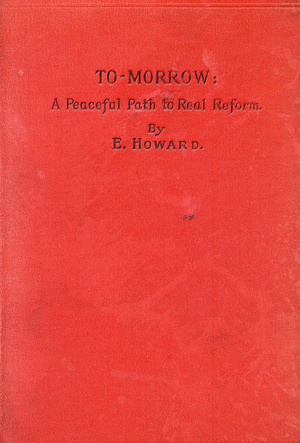 Ebenezer Howard, To-morrow: A Peaceful Path to Real Reform.
Ebenezer Howard, To-morrow: A Peaceful Path to Real Reform.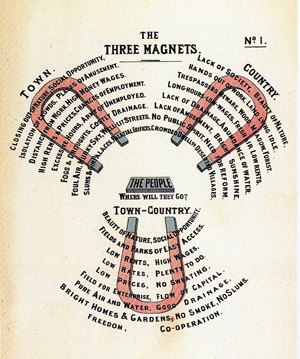 Diagram No.1: The Three Magnets (Ebenezer Howard, To-morrow: A Peaceful Path to Real Reform.)
Diagram No.1: The Three Magnets (Ebenezer Howard, To-morrow: A Peaceful Path to Real Reform.)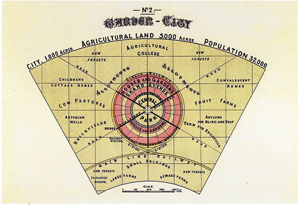 Diagram No.2 (Ebenezer Howard, To-morrow: A Peaceful Path to Real Reform.)
Diagram No.2 (Ebenezer Howard, To-morrow: A Peaceful Path to Real Reform.)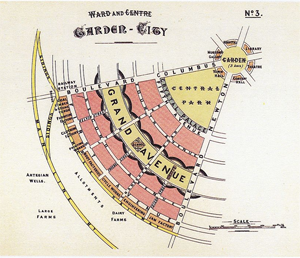 Diagram No.3 (Ebenezer Howard, To-morrow: A Peaceful Path to Real Reform.)
Diagram No.3 (Ebenezer Howard, To-morrow: A Peaceful Path to Real Reform.)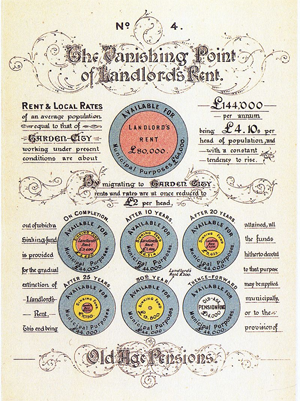 Diagram No.4 (Ebenezer Howard, To-morrow: A Peaceful Path to Real Reform.)
Diagram No.4 (Ebenezer Howard, To-morrow: A Peaceful Path to Real Reform.)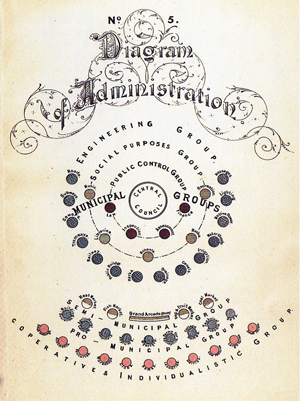 Diagram No.5 (Ebenezer Howard, To-morrow: A Peaceful Path to Real Reform.)
Diagram No.5 (Ebenezer Howard, To-morrow: A Peaceful Path to Real Reform.)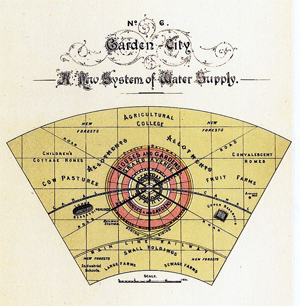 Diagram No.6 (Ebenezer Howard, To-morrow: A Peaceful Path to Real Reform.)
Diagram No.6 (Ebenezer Howard, To-morrow: A Peaceful Path to Real Reform.)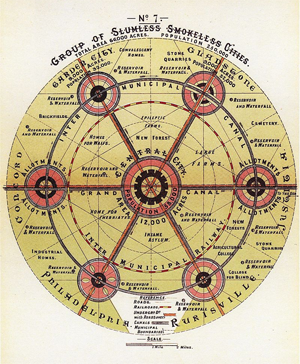 Diagram No.7 (Ebenezer Howard, To-morrow: A Peaceful Path to Real Reform.)Diagrams from the 1922 edition
Diagram No.7 (Ebenezer Howard, To-morrow: A Peaceful Path to Real Reform.)Diagrams from the 1922 edition Ebenezer Howard, Garden Cities of To-morrow.
Ebenezer Howard, Garden Cities of To-morrow.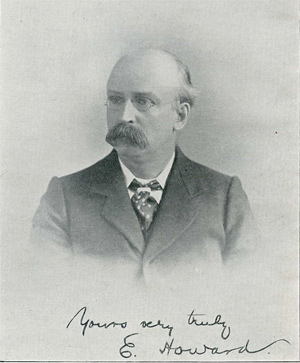 Ebenezer Howard, Garden Cities of To-morrow.
Ebenezer Howard, Garden Cities of To-morrow.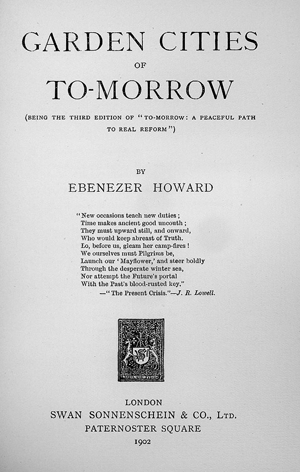 Ebenezer Howard, Garden Cities of To-morrow.
Ebenezer Howard, Garden Cities of To-morrow.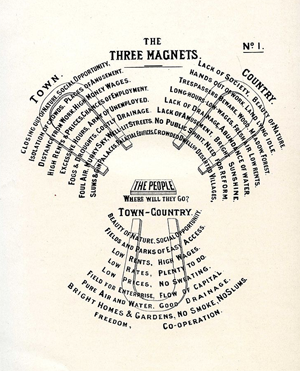 Diagram No.1 (Ebenezer Howard, Garden Cities of To-morrow.)
Diagram No.1 (Ebenezer Howard, Garden Cities of To-morrow.)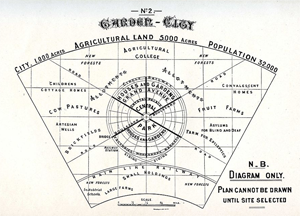 Diagram No.2 (Ebenezer Howard, Garden Cities of To-morrow.)
Diagram No.2 (Ebenezer Howard, Garden Cities of To-morrow.)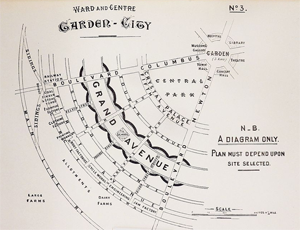 Diagram No.3 (Ebenezer Howard, Garden Cities of To-morrow.)
Diagram No.3 (Ebenezer Howard, Garden Cities of To-morrow.)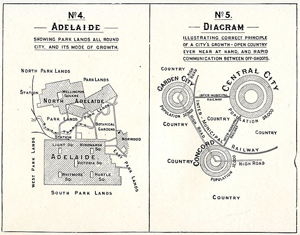 Diagram No.4 (Ebenezer Howard, Garden Cities of To-morrow.)"Den-en Toshi (Garden City)" Tokyo: Hakubunkan, 1907
Diagram No.4 (Ebenezer Howard, Garden Cities of To-morrow.)"Den-en Toshi (Garden City)" Tokyo: Hakubunkan, 1907 "Den-en Toshi (Garden City)" Tokyo: Hakubunkan, 1907.
"Den-en Toshi (Garden City)" Tokyo: Hakubunkan, 1907. "Den-en Toshi (Garden City)" Tokyo: Hakubunkan, 1907.
"Den-en Toshi (Garden City)" Tokyo: Hakubunkan, 1907.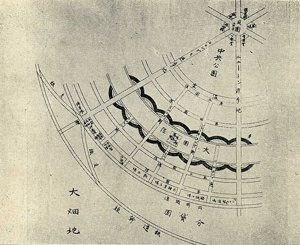 Diagram No.1 ("Den-en Toshi (Garden City)" Tokyo: Hakubunkan, 1907.)
Diagram No.1 ("Den-en Toshi (Garden City)" Tokyo: Hakubunkan, 1907.) Diagram No.2 ("Den-en Toshi (Garden City)" Tokyo: Hakubunkan, 1907.)
Diagram No.2 ("Den-en Toshi (Garden City)" Tokyo: Hakubunkan, 1907.) "Den-en Toshi (Garden City)" Tokyo: Hakubunkan, 1907.Garden suburbs
"Den-en Toshi (Garden City)" Tokyo: Hakubunkan, 1907.Garden suburbsThe concept of garden cities is to produce relatively economically independent cities with short commute times and the preservation of the countryside. Garden suburbs arguably do the opposite. Garden suburbs are built on the outskirts of large cities with no sections of industry. They are therefore dependent on reliable transport allowing workers to commute into the city.[43] Lewis Mumford, one of Howard’s disciples, explained the difference as "The Garden City, as Howard defined it, is not a suburb but the antithesis of a suburb: not a rural retreat, but a more integrated foundation for an effective urban life."[44]
The planned garden suburb emerged in the late 19th century as a by-product of new types of transportation were embraced by a newly prosperous merchant class. The first garden villages were built by English estate owners, who wanted to relocate or rebuild villages on their lands. It was in these cases that architects first began designing small houses. Early examples include Harewood and Milton Abbas. Major innovations that defined early garden suburbs and subsequent suburban town planning include linking villa-like homes with landscaped public spaces and roads.[45]
Despite the emergence of the garden suburb in England, the typology flowered in the second half of the 19th century in United States. There were generally two garden suburb typologies, the garden village and the garden enclave. The garden villages are spatially independent of the city but remain connected to the city by railroads, streetcars, and later automobiles. The villages often included shops and civic buildings. In contrast, garden enclaves are typically strictly residential and emphasize natural and private space, instead of public and community space. The urban form of the enclaves was often coordinated through the use of early land use controls typical of modern zoning, including controlled setbacks, landscaping, and materials.[46]
Garden suburbs were not part of Howard’s plan[47] and were actually a hindrance to garden city planning—they were in fact almost the antithesis of Howard’s plan, what he tried to prevent. The suburbanisation of London was an increasing problem which Howard attempted to solve with his garden city model, which attempted to end urban sprawl by the sheer inhibition of land speculation due to the land being held in trust, and the inclusion of agricultural areas on the city outskirts.[48]
Raymond Unwin, one of Howard’s early collaborators on the Letchworth Garden City project in 1907, became very influential in formalizing the garden city principles in the design of suburbs through his work Town Planning in Practice: An Introduction to the Art of Designing Cities and Suburbs (1909). [49] The book strongly influenced the Housing and Town Planning Act of 1909, which provided municipalities the power to develop urban plans for new suburban communities.[50]
Smaller developments were also inspired by the garden city philosophy and were modified to allow for residential “garden suburbs” without the commercial and industrial components of the garden city.[51] They were built on the outskirts of cities, in rural settings. Some notable examples being, in London, Hampstead Garden Suburb, the Sutton Garden Suburb in Benhilton, Sutton, Pinner's Pinnerwood conversation area and the 'Exhibition Estate' in Gidea Park and, in Liverpool, Wavertree Garden Suburb. The Gidea Park estate in particular was built during two main periods of activity, 1911 and 1934. Both resulted in some good examples of domestic architecture, by such architects as Wells Coates and Berthold Lubetkin. Thanks to such strongly conservative local residents’ associations as the Civic Society, both Hampstead and Gidea Park retain much of their original character.
However it is important to note Bournville Village Trust in SW Birmingham UK. This important residential development was associated with the growth of ‘Cadbury’s Factory in a Garden’. Here garden city principles are a fundamental part of the Trust’s activity. There are very tight restrictions applying to the properties here, no stonewall cladding, uPVC windows, and so on.
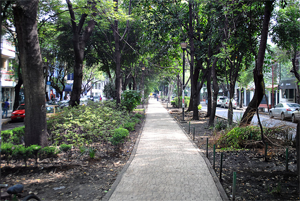 Park median in Avenida Ámsterdam, the "grand avenue" of the Mexico City subdivision Colonia Hipódromo de la Condesa, designed in 1926 and inspired in part by Ebenezer Howard's Garden City
Park median in Avenida Ámsterdam, the "grand avenue" of the Mexico City subdivision Colonia Hipódromo de la Condesa, designed in 1926 and inspired in part by Ebenezer Howard's Garden CityHoward's influence reached as far as Mexico City, where architect José Luis Cuevas was influenced by the garden city concept in the design of two of the most iconic inner-city subdivisions, Colonia Hipódromo de la Condesa (1926) and Lomas de Chapultepec (1928-9):[52]
• In 1926, Colonia Hipódromo[53] (a.k.a. Hipódromo de la Condesa), in what is now known as the Condesa area, including its iconic parks Parque México and Parque España
• In 1928-29, Lomas de Chapultepec
The subdivisions were based on the principles of the garden city as promoted by Ebenezer Howard, including ample parks and other open spaces, park islands in the middle of “grand avenues”, such as Avenida Amsterdam in colonia Hipódromo.[52] One unique example of a garden suburb is the Humberstone Garden Suburb in the United Kingdom by the Humberstone Anchor Tenants’ Association in Leicestershire, and it is the only garden suburb ever to be built by the members of a workers’ co-operative; it remains intact to the present.[54] In 1887 the workers of the Anchor Shoe Company in Humberstone formed a workers' cooperative and built 97 houses.
American architects and partners, Walter Burley Griffin and Marion Mahony Griffin[55] were proponents of the movement and after their arrival in Australia to design the national capital Canberra, they produced a number of garden suburb estates, most notably at Eaglemont with the Glenard and Mount Eagle Estates and the Ranelagh and Milleara Estates in Victoria.
See also• Gardening portal
• Charles Reade
• City Beautiful movement
Related urban design concepts• Transition Towns
• European Urban Renaissance
• Transit Oriented Development
• Urban forest
• Principles of Intelligent Urbanism
• Subsistence Homesteads Division
• Soviet urban planning ideologies of the 1920s
• EPCOT (concept)
Notes1. Examples being the ancient city of Chan Chan (20 km2 (7.7 sq mi), 850 AD) in Trujillo, north of Lima, and the 12th-century Inca city of Machu Picchu. Peru's modern capital, Lima, was designed in 1535 by Spanish Conquistadors to replace its ancient past as a religious sanctuary with 37 pyramids.
References
Citations1. Caves, R. W. (2004). Encyclopedia of the City. Routledge. p. 281.
2. Goodall, B (1987), Dictionary of Human Geography, London: Penguin.
3. Howard, E (1902), Garden Cities of To-morrow (2nd ed.), London: S. Sonnenschein & Co, pp. 2–7.
4. Fainstein & Campbell 2003, p. 42.
5. Hardy 1999, p. 4.
6. Fainstein & Campbell 2003, p. 43.
7. Fainstein & Campbell 2003, p. 46.
8. Fainstein & Campbell 2003, p. 47.
9. Hall 2002, p. 68.
10. Fainstein & Campbell 2003, p. 48.
11. Fainstein & Campbell 2003, p. 50.
12. Hall 2002, p. 100.
13. Hall & Ward 1998, pp. 45–7.
14. Hardy 1999, p. 8.
15. Hall & Ward 1998, p. 46.
16. Hall & Ward 1998, pp. 52–3.
17. History 1899–1999 (PDF), TCPA, archived from the original (PDF) on 2011-07-27.
18. Horley, Robert (1998). The Best Kept Secrets of Parma, "The Garden City". Robert Horley. ISBN 0-9661721-0-8.
19. "{title}". Archived from the original on 2018-08-08. Retrieved 2018-10-25.
20. "{title}". Archived from the original on 2013-10-05. Retrieved 2013-02-03.
21. 37676518 (photogram), Panoramio, archived from the original on 2017-06-25, retrieved 2017-12-02.
22. "City of Mitcham - History Pages". Archived from the original on 2009-10-12. Retrieved 2009-09-08.
23. "HV McKay memorial gardens", Victorian Heritage Database, Vic, AU: The Government, archivedfrom the original on 2009-12-04, retrieved 2009-08-28.
24. "2000 Study Site N 068—Albion—HO Selwyn Park", Post-contact Cultural Heritage Study (PDF), Vic, AU: Brimbank City Council, archived from the original (PDF) on 2009-10-22.
25. Sue Jackson-Stepowski (2008). "Haberfield". Archived from the original on 2016-03-04. Retrieved 2016-04-26.
26. Webberley, Helen (2008), Town-planning in a Brand New City, Brisbane: AAANZ Conference, archived from the original on 2010-01-12, retrieved 2009-01-25.
27. "{title}". Archived from the original on 2015-05-18. Retrieved 2015-05-14.
28. "City in a Garden" (PDF). Archived from the original (PDF) on 2012-09-14. Retrieved 2017-02-19.
29. "National Parks Board". Archived from the original on 2017-02-26. Retrieved 2017-02-19.
30. "Over 90 years of community building".
http://www.gardencities.co.za. Archived from the original on 2014-09-24. Retrieved 2014-10-14.
31. A. Trystan Edwards (January 1914). "A Further Criticism of the Garden City Movement". The Town Planning Review. 4 (4): 312–318. JSTOR 40100071.
32. Stephen Ward (18 October 2005). The Garden City: Past, present and future. Routledge. pp. 205–. ISBN 978-1-135-82895-0.
33. Dylan Welch (2009-01-08). "Demolition ordered for Rosemeadow estate". The Sydney Morning Herald. Archived from the original on 2015-09-24. Retrieved 2015-09-17.
34. Garden Cities Archived 2013-08-12 at the Wayback Machine at Town and Country Planning Association
35. "Creating Garden Cities and Suburbs Today - a guide for councils" Archived 2013-07-06 at the Wayback Machine
36. Letchworth Declaration
37. Cabannes, Yves; Ross, Philip (2015-02-13). 21st Century Garden Cities of To-morrow: A manifesto. Lulu.com. ISBN 978-1-291-47827-3.
38. "Ebbsfleet: Britain's first new garden city". The Telegraph. Archived from the original on 2016-09-20. Retrieved 1 July 2016.
39. "Bicester chosen as new garden city with 13,000 homes". BBC News. BBC. Archived from the original on 2016-07-17. Retrieved 1 July 2016.
40. "New garden towns to create thousands of new homes". Gov.uk. United Kingdom Government. Archived from the original on 2016-09-17. Retrieved 1 July 2016.
41. "Black Country Garden City to get 45,000 new homes". BBC News. BBC. Archived from the original on 2016-10-01. Retrieved 1 July 2016.
42. "{title}". Archived from the original on 2018-01-16. Retrieved 2018-04-04.
43. Hall & Ward 1998, p. 41.
44. Stern, Robert A.M.; Fishman, David; Tilove, Jacob (2013). Paradise Planned: The Garden Suburb and the Modern City. The Monacelli Press. pp. 17–19. ISBN 1580933262.
45. Stern, Robert A.M.; Fishman, David; Tilove, Jacob (2013). Paradise Planned: The Garden Suburb and the Modern City. The Monacelli Press. ISBN 1580933262.
46. Stern, Robert A.M.; Fishman, David; Tilove, Jacob (2013). Paradise Planned: The Garden Suburb and the Modern City. The Monacelli Press. p. 48. ISBN 1580933262.
47. Hall, Peter (1996), "4", Cities of Tomorrow, Oxford: BlackWell.
48. Design on the Land.
49. Hall 2002, pp. 110–12.
50. Stern, Robert A.M.; Fishman, David; Tilove, Jacob (2013). Paradise Planned: The Garden Suburb and the Modern City. The Monacelli Press. p. 214. ISBN 1580933262.
51. Hollow, Matthew (2011). "Suburban Ideals on England's Interwar Council Estates". Archived from the original on 2013-08-11. Retrieved 2012-12-29.
52. Manuel Sánchez de Carmona; et al., El trazo de Las Lomas y de la Hipódromo Condesa (PDF)(in Spanish), archived from the original (PDF) on 2013-10-29
53. ""Histoira de la Arquitectura Mexicana", Gabriela Piña Olivares, Autonomous University of Hidalgo" (PDF). Archived (PDF) from the original on 2013-10-29. Retrieved 2013-10-24.
54. "Humberstone Garden Suburb". UK: Utopia Britannica. Archived from the original on 2011-07-18. Retrieved 2011-03-28.
55. Goad, Philip (2012). The Encyclopedia of Australian Architecture. Cambridge University Press.
Sources
Works cited• Fainstein, S; Campbell, S (2003), Readings in planning theory, Malden, Massachusetts: Blackwell.
• Hall, P (2002), Cities of Tomorrow (3rd ed.), Malden, Massachusetts: Blackwell.
• ———; Ward, C (1998), Sociable Cities: the Legacy of Ebenezer Howard, Chichester: John Wiley & Sons.
• Hardy, D (1999), 1899–1999, London, England: Town and Country Planning Association.
Bibliography[edit]
• Meacham, Standish. Regaining Paradise: Englishness and the Early Garden City Movement (1999).
• Ross, P; Cabannes, Y (2012), 21st Century Garden Cities of To-morrow - How to become a Garden City, Letchworth Garden City: New Garden City Movement.
External links• Sir Ebenezer Howard and the Garden City Movement Norman Lucey 1973
• Patrick Barkham Britain’s housing crisis: are garden cities the answer? 2 October 2014
• L. Bigon and Y. Katz (eds 2014), Garden Cities and Colonial Planning: Transnationality and Urban Ideas in Africa and Palestine Manchester, New York: Manchester University Press.
• Nature Meets Culture: Poland’s Garden Cities
